
Sounds
from Amateur Radio Satellites 1986-1995 |
 
|
|
This section is dedicated
to satellites built and operated by Radio Amateurs.
Satellites built by AMSAT organizations around the world
and were called AMSAT-OSCAR. Those built by Russian
Hams and were mostly called Radiosputnik. In order to
build and launch the satellites AMSAT needs members
and friends to contribute and raise funds. If you are
not yet a member of AMSAT please consider to join us
and to support the activities. You can find several
links to AMSAT on my links page. |
My special
thanks to Roy W0SL, Jim N4ST, Don KD4APP, Darrel AA7FV,
Jim N5JDB, Clive G3CWV, Mike DK3WN, Reinhard DJ1KM +,
Michael DG1CMZ, Oliver DG6BCE, Peter DF2JB, Volker DF7IT,
Jean-Louis F6AGR, Thomas HB9SKA, Christoph HB9HAL, Claudio
IK1SLD, Andreas OE1DMB, Michael PA3BHF, Henk PA3GUO,
Darek SP9TTX, Ricardo PY3VHQ, Keith ZS6TW, Don N4UJW,
Vladimir RA3DQT, Paulo CT1ETE, John KD2BD, Harald DH8HHA,
Maik Hermenau, Ian ZL1AOX, Gerd DL8DR, Michael OH2AUE,
Robert G8ATE, Wouter Jan Ubbels PE4WJ, Mark KF6KYI,
Al W8KHP, Drew KO4MA, Rolf DK2ZF, Dave WB6LLO, Graham
G3VZV, Joe K0VTY, Nils von Storch, Zeljko 9A2EY, Pierre
ZS6BB, Bent OZ6BL, Mariano CT1XI, Al GM1SXX, Luc LU1FAM,
Matt SQ7DQX, Lance K6GSJ, Chris VK3AML, Bob VE6BLD,
Sergej RV3DR, Alex VK5ALX, Rudolf ZS6FX, Dick Daniels
W4PUJ/SK , Bob Patterson K5DZE, Jean-Louis Rault F6AGR,
Ivano Bonesana, Patrick Hajagos, Luc Leblanc VE2DWE,
Mike N1JEZ, John K6YK, Tetsu-san JA0CAW, Marco Bauer,
Carl Lindberg SM6NZV, Philip G0ISW, Kuge-san JE1CVL,
Pat AA6EG, John M0UKD, Paul Marsh M0EYT, Federico Manzini,
Jan PE0SAT, Domenico I8CVS +, Roland Zurmely PY4ZBZ,
Rob Hardenberg PE1ITR, Michael Kirkhart KD8QBA, Davide
D'Aliesio IW0HLG, Francisco EA7ADI, Kubota-san, Noguchi-san
JA5BLZ, Kuge-san JE1CVL, Luciano PY5LF, Wakita-san JE9PEL,
Peter ON4EZJ, Enrico IW2AGJ, Jean-Pierre F5YG, Remco
PA3FYM, Dave G0CER, Jose Maria EA2JX, Viljo ES5PC, Charly
DK3ZL, Bernd DL6IAN, Gustavo LW2DTZ, Juergen DL8SDQ,
Gary ZS6YI, Wilhelm DL6DCA, Bence Szabo, Alex KR1ST,
Branko 9A3ST, Daniel DL7NDR, Michael Hoerenberg, Igor
PU4ELT, Tom SP5LOT, Nina DL2GRC and Udea san JA0FKM
for kindly contributing to this collection ! |
Picture |
Satellite
#NORAD |
Description |
Launch Date |

|
MIR Space
Station
#16609
(1986-017A) |
 Another
way to use large space objects is to use them as passive
reflectors. MIR indeed was large enough to scatter enough
signal back to Earth. The audio file enclosed was recorded
by Jean-Louis F6AGR on Feb. 21st
2001. He received CW (morse code) signals, which were
transmitted on 144 MHz by F6ETI. Another
way to use large space objects is to use them as passive
reflectors. MIR indeed was large enough to scatter enough
signal back to Earth. The audio file enclosed was recorded
by Jean-Louis F6AGR on Feb. 21st
2001. He received CW (morse code) signals, which were
transmitted on 144 MHz by F6ETI.
|
Feb 20th
1986 |
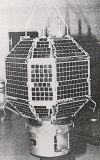
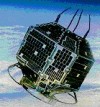
|
Fuji
OSCAR 12
FO-12
JAS-1A
#16909
(1986-061B) |
FO-12 (JAS-1A) was developed
by Japan Amateur Radio League with system design and
integration done by NEC. It was launched aboard a H-I
launcher piggyback with a Japanese experimental geodetic
satellite Ajisai (EGS). Its circular orbit (1490km)
was inclined by 50 degrees. It featured analog (JA)
and digital (JD) transponders with uplink frequencies
in 2m band and downlink frequencies in 70cm band (output
power was 1 Watt). FO-12 operated until November 5th
1989 when the batteries failed. |
Aug
12th 1986 |
I am searching
for sound files. Please send them to
 |
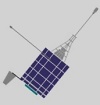
|
RS
10/11
COSMOS 1861
#18129
(1987-054A) |
RS-10 and
RS-11 were tandem loads integrated into a navigation
satellite called Cosmos 1861. This satellite was launched
into a circular orbit with an altitude of 996 km and
an inclination of 83 degrees. RS-10 and RS-11 supported
the following modes: A, K, T, KA and KT with an output
power of 5 Watts. |
Jun
24th 1987 |
 RS-10
in Robot mode, AA3O transmitted in CW on the 2m uplink
and the satellite responded with a QSO# on the 10m downlink,
recorded by N4ST (ex AA3O) RS-10
in Robot mode, AA3O transmitted in CW on the 2m uplink
and the satellite responded with a QSO# on the 10m downlink,
recorded by N4ST (ex AA3O)
|
 RS-11
CW telemetry signal on 10m downlink recorded by Jim
N4ST RS-11
CW telemetry signal on 10m downlink recorded by Jim
N4ST
|
 RS-11
in Robot mode, QSO of KD2BD on March 6th
1988. John used an 2m FM transmitter which he keyed
to generate a CW signal. Recording kindly provided by
John KD2BD. RS-11
in Robot mode, QSO of KD2BD on March 6th
1988. John used an 2m FM transmitter which he keyed
to generate a CW signal. Recording kindly provided by
John KD2BD.
|



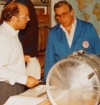

|
AMSAT
OSCAR 13
AO-13
Phase-3C
#19216
(1988-051B) |
AO-13 was
launched on June 15th 1988
on an Ariane-4 rocket from Kourou/French Guiana. It
was at its time the most powerful Amateur Radio communications
satellite. AO-13 was in a highly elliptical orbit, which
provided the spacecraft outstanding DX potential over
the world's most populated regions (Asia, North America
and Europe).
AO-13 carried four beacon transmitters
and four linear transponders. The beacon downlinks were:
Mode V (General beacon): 145.812 MHz CW/RTTY/PSK
Mode V (Engin. beacon): 145.985 MHz PSK
Mode U (General
beacon):435.652 MHz PSK
Mode S (Engin. beacon):
2400.664 MHz PSK
The most used transponders were:
Mode U/V (B) Linear Transponder (Inverting):
Uplink:
435.573 - 435.423 MHz LSB/CW
Downlink:
145.825 - 145.975 MHz USB/CW
Mode V/L/U Linear Transponder
(Inverting):
Uplink: 2m
SSB/CW
Uplink: 23cm SSB/CW
Downlink: 70cm SSB/CW
Mode
U/S Linear Transponder (Inverting):
Uplink:
435.602 - 435.638 MHz LSB/CW
Downlink:
2400.711 - 2400.747 MHz USB/CW
 In
November 1998, after 8 years of operation, the solar
panels failed as they got very hot during low perigee
passes in the dense atmosphere. The plot enclosed shows
such a transition recorded on November 23rd
1998 in orbit 6479. AO-13 finally decayed on December
5th 1996. In
November 1998, after 8 years of operation, the solar
panels failed as they got very hot during low perigee
passes in the dense atmosphere. The plot enclosed shows
such a transition recorded on November 23rd
1998 in orbit 6479. AO-13 finally decayed on December
5th 1996. |
Jun
15th 1988
|
 The first
ZRO test (in memoriam of K2ZRO) was conducted via AO-10
on May 5th 1985 at 11:30 UTC
in Mode B (145.850 MHz downlink). From then on ZRO tests
were regularly conducted on AO-10 and later also on
AO-13. During these tests a Morse signal with decreasing
power level was transmitted and thus allowed the user
to evaluate the performance of his receiving system.
Enclosed you can hear the ZRO transmission on 145 MHz
via OSCAR 13 from Andy MacAllister, on 24 April 1993.
The file contains about 6 minutes of continuous data,
starting with ZRO level 8 data, (24 dB below the beacon)
including the level 9 (-27 dB) and level A (-30 dB)
signal, finishing with the "End of test" message
at full power. Recorded by Darrel AA7FV. The first
ZRO test (in memoriam of K2ZRO) was conducted via AO-10
on May 5th 1985 at 11:30 UTC
in Mode B (145.850 MHz downlink). From then on ZRO tests
were regularly conducted on AO-10 and later also on
AO-13. During these tests a Morse signal with decreasing
power level was transmitted and thus allowed the user
to evaluate the performance of his receiving system.
Enclosed you can hear the ZRO transmission on 145 MHz
via OSCAR 13 from Andy MacAllister, on 24 April 1993.
The file contains about 6 minutes of continuous data,
starting with ZRO level 8 data, (24 dB below the beacon)
including the level 9 (-27 dB) and level A (-30 dB)
signal, finishing with the "End of test" message
at full power. Recorded by Darrel AA7FV.
|
    On April
11th 1989 Dave WB6LLO recorded
the 2m PSK beacon which transmitted at 400BPS. The mp3
files are smaller in size and thus quicker to download.
However I added also wav files in case someone wants
to use them to test his telemetry decoder. On April
11th 1989 Dave WB6LLO recorded
the 2m PSK beacon which transmitted at 400BPS. The mp3
files are smaller in size and thus quicker to download.
However I added also wav files in case someone wants
to use them to test his telemetry decoder.
|
  On April
11th 1989 Dave Guimont WB6LLO
recorded the Mode-B (2m) downlink of AO-13 with several
SSB signals. On April
11th 1989 Dave Guimont WB6LLO
recorded the Mode-B (2m) downlink of AO-13 with several
SSB signals.
|
 Here
is another station calling WB6LLO but he is missing
the "B" in his callsign. Recorded also in
April 1989 (AO-13 Mode B orbit #633) by Dave WB6LLO. Here
is another station calling WB6LLO but he is missing
the "B" in his callsign. Recorded also in
April 1989 (AO-13 Mode B orbit #633) by Dave WB6LLO.
|
 QSO of
CT1BQN and JA4EV on AO13. Recorded by Darek SP9TTX (this
complete QSO is 4 MBytes large). QSO of
CT1BQN and JA4EV on AO13. Recorded by Darek SP9TTX (this
complete QSO is 4 MBytes large).
|
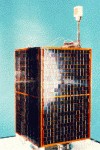
|
UoSAT
OSCAR 14
UO-14
UoSAT-3
Healthsat-1
#20437
(1990-005B) |
UoSAT OSCAR 14 was launched
together with UoSAT OSCAR 15 from Kourou on the Ariane
flight V35 ASAP into a sun-synchronous orbit (hight
780km, inclination 98 degree). The primary payload of
this Ariane launch was SPOT-2.
The primary purpose
UO-14, a 46kg 3-axis stabilized satellite, was a digital
Store and Forward communications transponder supporting
multiple access from hundreds of portable groundstations.
It was particularly suited to communications in remote
or disaster-stricken areas. Two experimental payloads
were included to monitor the radiation environment experienced
by the satellite in Low Earth Orbit (LEO), measuring
cosmic particles, and total radiation dose.
UoSAT-OSCAR14
spent its first 18 months in orbit operating as an amateur
store and forward satellite. In early 1992, all amateur
operations were moved from UO-14 to UoSAT-OSCAR 22.
UO-14 operations were then dedicated for use by VITA
(Volunteers In Technical Assistance) who used it for
sending and receiving messages escpecially medical data
transmissions in Africa (service was called also Satelife
and UO-14 was renamed to Healthsat-1). When the computer
used for store and forward communications became non-operational,
in March 2000 UO-14 was re-configured as a very popular
single channel FM repeater in space. Frequencies used
were:
Uplink: 145.975
MHz (9600 bps FSK AX.25) or analog FM
Downlink:
435.070 MHz (9600 bps FSK AX.25) or analog FM
Beacon:
435.070 MHz (1200 bps AFSK (NBFM)
AX.25)
UoSAT-3 was taken out of service in August
2003 due to insufficient power from the rechargeable
batteries which lost their capacity. |
Jan
22nd 1990 |
 QSOs
of DL1LSZ and F6HCC using the FM repeater mode on February
25th 2002, recorded by DK3WN QSOs
of DL1LSZ and F6HCC using the FM repeater mode on February
25th 2002, recorded by DK3WN
|
 Multiple
QSOs of Don KD4APP on May 19th
2002. Multiple
QSOs of Don KD4APP on May 19th
2002.
|

|
UoSAT
OSCAR 15
UO-15
UoSAT-4
#20438
(1990-005C) |
UoSAT OSCAR 15 was launched
together with UoSAT OSCAR 14 from Kourou on the Ariane
flight V35 ASAP into a sun-synchronous orbit (hight
780km, inclination 98 degree). The primary payload of
this Ariane launch was SPOT-2.
The RF system on
UoSAT-4 consisted of three VHF receivers and two UHF
transmitters. During normal operation all receivers
were active and one downlink could be selected via a
telecommand operated relay. Up and down link data rates
were 1200 AFSK and 9600 FSK, though only 1200 AFSK was
used during the commissioning phase. The transmitter
output power was set to 1.5 watts during acquisition
could have be switched up to 5 Watts.
UoSAT-4 failed
30 hours after launch, thus most likely no recordings
of its transmissions are available.
I am searching
for sound files. Please send them to
 |
Jan 22nd
1990 |
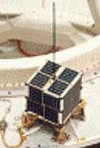
|
AMSAT
OSCAR 16
PO-16
PacSat
#20439
(1990-005D) |
 PSK signal
recorded by DK3WN PSK signal
recorded by DK3WN
|
Jan
22nd 1990 |
 1200Bd
Manchester coded FM signal recorded by DK3WN 1200Bd
Manchester coded FM signal recorded by DK3WN
|
 Recorded
by Don Woodward, KD4APP, Oct 5th
2002 Recorded
by Don Woodward, KD4APP, Oct 5th
2002
|
 SSB downlink
signal received by Mark KF6KYI on February 23rd
2008. SSB downlink
signal received by Mark KF6KYI on February 23rd
2008.
|
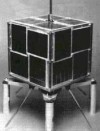
|
Dove
OSCAR 17
DO-17
#20440
(1990-005E) |
 DO-17
included a Digital Orbiting Voice Encoder. Please listen
to the enclosed synthesized voice message. DO-17
included a Digital Orbiting Voice Encoder. Please listen
to the enclosed synthesized voice message.
|
Jan
22nd 1990 |
 This
recording was done during a DAC test transmission. This
recording was done during a DAC test transmission.
|
 The 1200Bd
AFSK signal was recorded by DK3WN The 1200Bd
AFSK signal was recorded by DK3WN
|
 The 2.4
GHz downlink carrier of AO17 shows a strong doppler
shift. Recorded by OH2AUE. The 2.4
GHz downlink carrier of AO17 shows a strong doppler
shift. Recorded by OH2AUE.
|
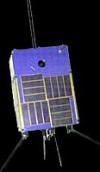
|
Weber
OSCAR 18
WO-18
#20441
(1990-005F) |
Sporting
a full-color CCD camera, WEBERSAT OSCAR-18 digitized
Earth images and downlinked them on 70cm as AX.25 serial
data streams. It also featured a packet radio mailbox
facility.
I am searching for sound files. Please
send them to
 |
Jan 22nd
1990 |
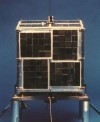
|
LuSat
OSCAR 19
LO-19
LUSAT-1
#20442
(1990-005G) |
 CW beacon
on 437.125 MHz recorded August 9th
2002 by KD4APP CW beacon
on 437.125 MHz recorded August 9th
2002 by KD4APP
|
Jan
22nd 1990 |
 BPSK
downlink (sporadic) recorded April 29th
2003 by KD4APP BPSK
downlink (sporadic) recorded April 29th
2003 by KD4APP
|
 CW signal
received on 437.125 MHz in FM mode by Mark KF6KYI on
January 20th 2008. CW signal
received on 437.125 MHz in FM mode by Mark KF6KYI on
January 20th 2008.
|
 CW signal
received on 437.125 MHz in CW mode by Mark KF6KYI on
January 28th 2008. CW signal
received on 437.125 MHz in CW mode by Mark KF6KYI on
January 28th 2008.
|
 On February
22nd 2009 at 15:42 UTC Patrick
DK193WN received the CW signal on 437.125 MHz. Recoding
kindly provided by Patrick Hajagos DK193WN. On February
22nd 2009 at 15:42 UTC Patrick
DK193WN received the CW signal on 437.125 MHz. Recoding
kindly provided by Patrick Hajagos DK193WN.
|
The LUSAT-1
CW beacon on 437.125 MHz quit transmitting in December
2012 after 23 years of operation. From thereon only
a very weak carrier from the local oscillator could
be heard. |
On June 9th
2013 the beacon of LUSAT-1 became operational again
with quite strong signals being received by radio amateurs
the around world. Modulation is CW without a Morse logic,
just some dots, regular spaces and sometimes a dash. |
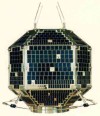
|
Fuji
OSCAR 20
FO-20
JAS-1B
#20480
(1990-013C) |
FO-20 was
the successor of FO-12. The 50 kg satellite was launched
by NASDA in Japan into an elliptical orbit with a perigee
of 912km, an apogee of 1745 km and an inclination of
99°. |
Feb
7th 1990 |
 QSO DL1LSZ
and G7RVM on March 17th 2002
16:02UTC recorded by DK3WN (ex DL1LSZ) QSO DL1LSZ
and G7RVM on March 17th 2002
16:02UTC recorded by DK3WN (ex DL1LSZ)
|
 Weak
beacon signal recorded September 6th
2002 by KD4APP, A0 test, changes in tone is generated
by Don's UniTrac control system changing the doppler Weak
beacon signal recorded September 6th
2002 by KD4APP, A0 test, changes in tone is generated
by Don's UniTrac control system changing the doppler
|
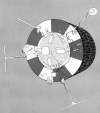

|
AMSAT
OSCAR 21
AO-21
Rudak 2
Radiosputnik 14
RS 14
Radio M-1
Informator-1
#21087
(1991-006A) |
This satellite
was a joint venture between the AMSAT organizations
in Russia and Germany. The amateur equipment rode piggyback
on a Russian experimental geological satellite (INFORMATOR-1).
The joint project was called Radio M-1 by the Russian
team (amateur radio satellite club Orbita and the Adventure
Club of Moscow) respectively Rudak-2 by the German hams
(at Marburg, Munich and Hannover). The collaboration
led to dual names for the new amateur radio satellite
once it arrived in orbit: AMSAT-OSCAR-21 (AO-21) and
Radiosputnik-14 (RS-14).
AO-21 was a very successful
and popular satellite as the 4 different receiving channels
in the 70cm band supported multiple modes. The computer
could generate differently modulated signals (BPSK,
AFSK, FSK, RSM, FM) and thus eight different modes could
be transmitted:
- 1200 bps, BPSK, NRZI (Fuji mode)
- 400 bps, BPSK, Biphase s, (Phase-3 mode)
- 2400 bps, BPSK, Biphase s, (Rudak-1 mode)
- 4800
bps, RSM, NRZIC
- 9600 bpses, RSM, NRZI + Scrambler
- CW
- FSK for RTTY, SSTV, FAX transmissions
- FM-modulated through a DSO RISC Processor |
Jan
29h 1991 |
 Test
transmission of the in-orbit functional checkout of
the DSP in RUDAK-2. Note at the beginning of the transmission
the BPSK data transmission. Test
transmission of the in-orbit functional checkout of
the DSP in RUDAK-2. Note at the beginning of the transmission
the BPSK data transmission.
|
 FM voice
message transmission of German AATiS (Arbeitskreis Amateurfunk
und Telekommunikation in der Schule) on 145.983 MHz.
Recorded between Oct 15th and
31st 1993. FM voice
message transmission of German AATiS (Arbeitskreis Amateurfunk
und Telekommunikation in der Schule) on 145.983 MHz.
Recorded between Oct 15th and
31st 1993.
|
 Voice
greetings in English and German. Recorded by OE1DMB. Voice
greetings in English and German. Recorded by OE1DMB.
|
 Voice
messages in Russian. Recorded by OE1DMB. Voice
messages in Russian. Recorded by OE1DMB.
|
 Voice
message in French. Recorded by SP9TTX. Voice
message in French. Recorded by SP9TTX.
|
 In memoriam
of the first man on the moon, In memoriam
of the first man on the moon,  which
was 25 years before, AO-21 re-transmitted in 1994 the
message of the Eagle-Crew as well as a SSTV picture.
Sound recorded by OE1DMB, SSTV recorded by SP9TTX. which
was 25 years before, AO-21 re-transmitted in 1994 the
message of the Eagle-Crew as well as a SSTV picture.
Sound recorded by OE1DMB, SSTV recorded by SP9TTX.
|
 Also JA0FKM
Ueda san in Japan recorded the transmissions from AO-21.
His recording includes the recording of the first man
on the moon as well as subsequent data transmitted by
AO-21. Sound recorded and kindly provided by JA0FKM
Udea san. Also JA0FKM
Ueda san in Japan recorded the transmissions from AO-21.
His recording includes the recording of the first man
on the moon as well as subsequent data transmitted by
AO-21. Sound recorded and kindly provided by JA0FKM
Udea san.
|
 QSO of
EA5ZM Artur and SP9TTX Darek. Recorded by Darek SP9TTX,
September 9th 1994. QSO of
EA5ZM Artur and SP9TTX Darek. Recorded by Darek SP9TTX,
September 9th 1994.
|
 Special
Christmas greeting (music) prepared by DB2OS and copied
with an IC2E hand-held by Michael OH2AUE. Special
Christmas greeting (music) prepared by DB2OS and copied
with an IC2E hand-held by Michael OH2AUE.
|
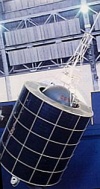
|
RS
12/13
COSMOS 2123
#21089
(1991-007A) |
RS-12 and RS-13 were
tandem loads integrated into a navigation satellite
called Cosmos 2123. Cosmos 2123 was based on the Tsikada
satellite platform and was launched into a circular
orbit with an altitude of 1000 km and an inclination
of 83 degrees. RS-12 and RS-13 supported the following
modes: A, K, T, KA and KT with an output power of 5
Watts. |
Feb
5th 1991 |
 RS12
CW robot transmission recorded by DK3WN, November 3rd
1999 RS12
CW robot transmission recorded by DK3WN, November 3rd
1999
|
 Strong
CW beacon signal from RS12 recorded by DK3WN, December
6th 2000 Strong
CW beacon signal from RS12 recorded by DK3WN, December
6th 2000
|
 Fading
CW beacon signal from RS12 recorded by Don Woodward,
KD4APP, July 27th 2002 Fading
CW beacon signal from RS12 recorded by Don Woodward,
KD4APP, July 27th 2002
|
 RS13
also featured a linear transponder with a 2m downlink.
You can hear several stations on the enclosed recording
which was kindly provided by Maik Hermenau. RS13
also featured a linear transponder with a 2m downlink.
You can hear several stations on the enclosed recording
which was kindly provided by Maik Hermenau.
|
 Rudolf
ZR6JRN (now ZS6FX) had a nice SSB contact with ZS6RY
via RS-13. Recording provided by Rudolf ZS6FX. Rudolf
ZR6JRN (now ZS6FX) had a nice SSB contact with ZS6RY
via RS-13. Recording provided by Rudolf ZS6FX.
|
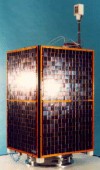
|
UoSAT
OSCAR 22
UO-22
UoSAT-5
UoSAT-F
#21575
(1991-050B) |
UoSAT OSCAR 22 was launched
on a Ariane 4 rocket from Kourou into a polar orbit.
Beside a CCD camera experiment it also featured a packet
radio store and forward mailbox. This 9600bd packet
radio (AX-25) mailbox had an uplink frequency of 145.900
MHz and a downlink frequency of 435.120 MHz. |
Jul
17th 1991 |
The S&F mailbox of
UO-22 was also used to transfer pictures and voice mails.
On March 22nd 1992 Peter DB2OS
uploaded a message to QO-22 and received 3 answers from
Jeff G0/K8KA, Ong G7JNV and Hans G7GRS which you can
find below. This was probably the first time voice mails
were exchanged via an Amateur Radio Satellite. The voice
was originally sampled with 6kHz, reduced using a 4
bit compression and encoded in VOC format. To be compatible
with today's browsers I converted them to mp3 format.
Unfortunately the original voice message from Peter
DB2OS is lost.
 Reply
1 from Jeff G0/K8KA Reply
1 from Jeff G0/K8KA
 Reply
2 from Ong G7JNV Reply
2 from Ong G7JNV
 Reply
3 from Hans G7GRS Reply
3 from Hans G7GRS
Audio recordings kindly provided
by Peter DB2OS. |
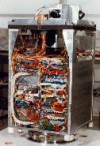
|
KitSat
OSCAR 23
KO-23
KitSat-1
Kitsat-A
#22077
(1992-052B) |
 KitSat
OSCAR 23 was a store and forward AX-25 packet radio
satellite built as joint project by Korean Advanced
Institute of Technology and British University of Surrey.
The 9600bd uplink frequencies in the 2m band were on
145.850 MHz and 145.900 MHz. The 9600bd downlink frequency
was 435.175 MHz. Normally the 9600bd downlink sounds
like noise. However during a malfunction on March 3rd
1999 at 08:10UTC Mike DK3WN recorded this unique downlink
signal. KitSat
OSCAR 23 was a store and forward AX-25 packet radio
satellite built as joint project by Korean Advanced
Institute of Technology and British University of Surrey.
The 9600bd uplink frequencies in the 2m band were on
145.850 MHz and 145.900 MHz. The 9600bd downlink frequency
was 435.175 MHz. Normally the 9600bd downlink sounds
like noise. However during a malfunction on March 3rd
1999 at 08:10UTC Mike DK3WN recorded this unique downlink
signal.
|
Aug 10th
1992 |
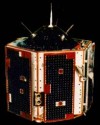
|
Arsene
OSCAR 24
AO-24
#22654
(1993-031B) |
 Arsene
OSCAR 24 was launched on May 13th
1993 on an Ariane V-56A rocket from Kourou into an equatorial
elliptical orbit. AO-24 was built by French Radio Amateur
Club de l'Espace and featured a Mode B as well as a
Mode S transponder. The Mode B transponder failed soon
after launch and thus the 145.975 MHz downlink (1200
bps FM AFSK) was never used. However Arsene OSCAR 24
could be used for several months as a SSB / CW linear
transponder with the Mode S downlink at 2446.54 MHz.until
this transponder failed as well. In the audio file enclosed
you can first hear the telemetry downlink, then JA3GCT
calling CQ and finally a QSO of HB9HAL and I6CGE. All
recorded on the S-Band downlink on August 7th
1993 by Christoph HB9HAL. Arsene
OSCAR 24 was launched on May 13th
1993 on an Ariane V-56A rocket from Kourou into an equatorial
elliptical orbit. AO-24 was built by French Radio Amateur
Club de l'Espace and featured a Mode B as well as a
Mode S transponder. The Mode B transponder failed soon
after launch and thus the 145.975 MHz downlink (1200
bps FM AFSK) was never used. However Arsene OSCAR 24
could be used for several months as a SSB / CW linear
transponder with the Mode S downlink at 2446.54 MHz.until
this transponder failed as well. In the audio file enclosed
you can first hear the telemetry downlink, then JA3GCT
calling CQ and finally a QSO of HB9HAL and I6CGE. All
recorded on the S-Band downlink on August 7th
1993 by Christoph HB9HAL.
|
May 12th
1993 |
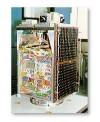
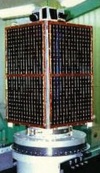
|
KitSat
OSCAR 25
KO-25
KitSat-2
Kitsat-B
#22828
(1993-061H) |
KitSat OSCAR 25 was launched
on Sepember 26th 1993 together
with 3 other Amateur Radio satellites on an Ariane 4
rocket from Kourou into a polar orbit with 98° inclination.
This successor of KO-23 included a CCD camera and multiple
other experiments. KO-25 is a store and forward AX-25
packet radio satellite using 9600bd FSK in up- and downlink.
The uplink frequencies are 145.870 MHz and 145.980 MHz,
the downlink frequency is 436.500 MHz. |
Sep
26th 1993 |
 The downlink
signal of KO-25 in the 70cm band was recorded by Don
Woodward, KD4APP, on Sept 7th
2002 The downlink
signal of KO-25 in the 70cm band was recorded by Don
Woodward, KD4APP, on Sept 7th
2002
|
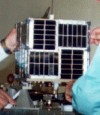
|
ITAMSAT
OSCAR 26
IO-26
ITAMSAT-1
#22826
(1993-061D) |
 Launched
on an Ariane 4 rocket the mission of IO-26 was to store
and forward amateur radio messages . Its signal was
recorded by Don Woodward, KD4APP, on Nov 14th
2002 Launched
on an Ariane 4 rocket the mission of IO-26 was to store
and forward amateur radio messages . Its signal was
recorded by Don Woodward, KD4APP, on Nov 14th
2002
|
Sep
26th 1993 |
 This
PSK downlink signal was recorded by DK3WN This
PSK downlink signal was recorded by DK3WN
|
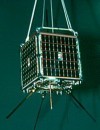
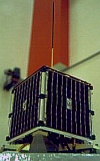
|
Amrad
OSCAR 27
AO-27
EYESAT-1
#22825
(1993-061C) |
EYESAT-1 was built by
AMRAD (Amateur Radio Research and Development Corporation).
It was one of six satellites that were launched together
on a Ariane V59 rocket from French Guiana. Once in orbit
and operational the amateur payload of EYESAT-1 was
designated AMRAD-OSCAR 27. AO-27 features a Mode V/U
(J) FM Voice Repeater. The uplink frequency of this
bent pipe FM repeater is 145.8500 MHz (FM), the downlink
frequency is 436.7950 MHz (FM). This satellite can be
worked with simple FM equipment and was also successfully
tested with D-Star. |
Sep
26th 1993 |
 QSOs
of DL1LSZ and DL2DRD on December 4th
1999, recorded by DK3WN QSOs
of DL1LSZ and DL2DRD on December 4th
1999, recorded by DK3WN
|
 QSOs
recorded by Don Woodward, KD4APP, Sept 8th
2002 QSOs
recorded by Don Woodward, KD4APP, Sept 8th
2002
|
 John
K6YK had a contact with Greg WB6FZH/KH6 via AO-27. Recording
kindly provided by John K6YK. John
K6YK had a contact with Greg WB6FZH/KH6 via AO-27. Recording
kindly provided by John K6YK.
|
 1200bd
Telemetry recorded by Don Woodward, KD4APP, Nov 19th
2002 1200bd
Telemetry recorded by Don Woodward, KD4APP, Nov 19th
2002
|
 Usually
analog FM voice transmissions are used via AO-27. However
the new DSTAR standard which is intended to be used
via terrestrial FM repeaters can be also used via satellite
as the test transmission of Luc Leblanc VE2DWE demonstrates.
He used an ICOM IC2200 TRX for the 436.795 MHz downlink
and a ICOM ID-800H for the 145.850 MHz uplink. Recorded
on September 5th 2009 at 22:49
UTC and kindly provided by VE2DWE. Usually
analog FM voice transmissions are used via AO-27. However
the new DSTAR standard which is intended to be used
via terrestrial FM repeaters can be also used via satellite
as the test transmission of Luc Leblanc VE2DWE demonstrates.
He used an ICOM IC2200 TRX for the 436.795 MHz downlink
and a ICOM ID-800H for the 145.850 MHz uplink. Recorded
on September 5th 2009 at 22:49
UTC and kindly provided by VE2DWE.
|
 After
16 years in orbit AO-27 was still operational. Enclosed
downlink signals on 436.797 MHz were recorded on March
14th 2010 at 12:21 UTC by DD1US
using an omnidirectional antenna. After
16 years in orbit AO-27 was still operational. Enclosed
downlink signals on 436.797 MHz were recorded on March
14th 2010 at 12:21 UTC by DD1US
using an omnidirectional antenna.
|
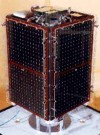
|
PoSat OSCAR
28
PO-28
PoSAT-1
#22829
(1993-061G) |
First Portuguese
Amateur Radio satellite. It was launched on a Ariane
V59 rocket from Kourou. The launch included the German
Stella Laser Reflector, Healthsat-II, KITSAT-OSCAR-25
(KO-25), Italy-OSCAR-26 (IO-26), Amrad OSCAR 27 (AO-27)
and PoSAT-1 (PO-28).
I am searching for sound files. Please
send them to
 |
Sep 26th
1993 |
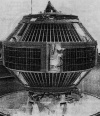
|
RS
15
#23439
(1994-085A) |
 CW telemetry
signal recorded by DK3WN, Sept 19th
2002 13:40UTC CW telemetry
signal recorded by DK3WN, Sept 19th
2002 13:40UTC
|
Dec
26th 1994 |
 Weak
CW beacon signal from RS15 on 29.352 MHz recorded by
KD4APP, Sept 30th 2002 Weak
CW beacon signal from RS15 on 29.352 MHz recorded by
KD4APP, Sept 30th 2002
|
 On June
14th 2009 at 08:20 UTC Henk
PA3GUO recorded the CW beacon of RS15. On June
14th 2009 at 08:20 UTC Henk
PA3GUO recorded the CW beacon of RS15.
|
Picture |
Satellite
#NORAD |
Description |
Launch Date |
If you
have further recordings from space objects please let
me know. I will be happy to add them to my homepage.
Many thanks in advance.
Vy 55 & 73 de
Matthias DD1US  |

 
|